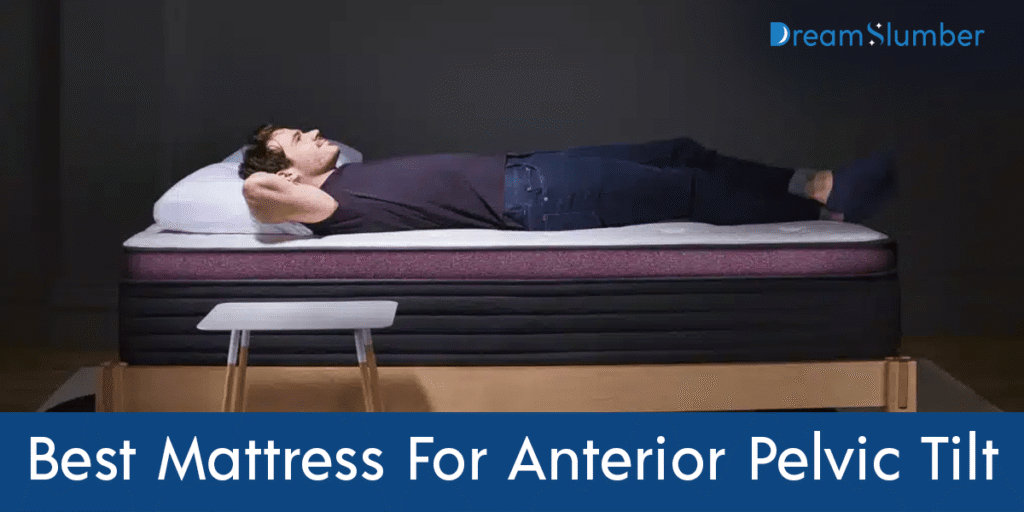When you purchase through our links, we may earn a commission at no extra cost to you. As an Amazon Associate, DreamSlumber earns from qualifying purchases. Learn more.
Waking up with lower back pain isn’t something you should get used to. For many living with anterior pelvic tilt (APT), it feels like an everyday struggle. APT is a postural imbalance where the pelvis tilts forward, exaggerating the curve in your lower spine. This posture strains muscles, tightens your hips, and often leaves you battling stiffness from the moment you wake up. This is where the best mattress for anterior pelvic tilt can help you sleep at ease without worrying much about the pain.
What makes mornings worse is spending eight hours on a mattress that doesn’t support your body’s natural alignment. Instead of healing, your muscles stay locked in the same stress-filled position all night. But when you rest on the right mattress, your spine settles, tight muscles release, and your body finds space to recover. So, scroll down to unlock comfort with our top 7 selections of mattresses for APT.
Top 7 Mattresses for Anterior Pelvic Tilt (2025 Expert Picks)
Whether you are a side sleeper or prefer sleeping on your back, you need a mattress that can help you manage your back pain and get optimal lumbar support. A hybrid mattress with structured coils and supportive layers of foam and latex gives you the nightly comfort you need. It conforms to the shape of your body to give the right support to your hips and shoulders, healing your APT.
To help you make the best buying decision, let us discuss some of the top-rated mattresses, backed by clinical research and expert reviews:
1. Saatva Rx – Best Overall and Medical-Grade Mattress
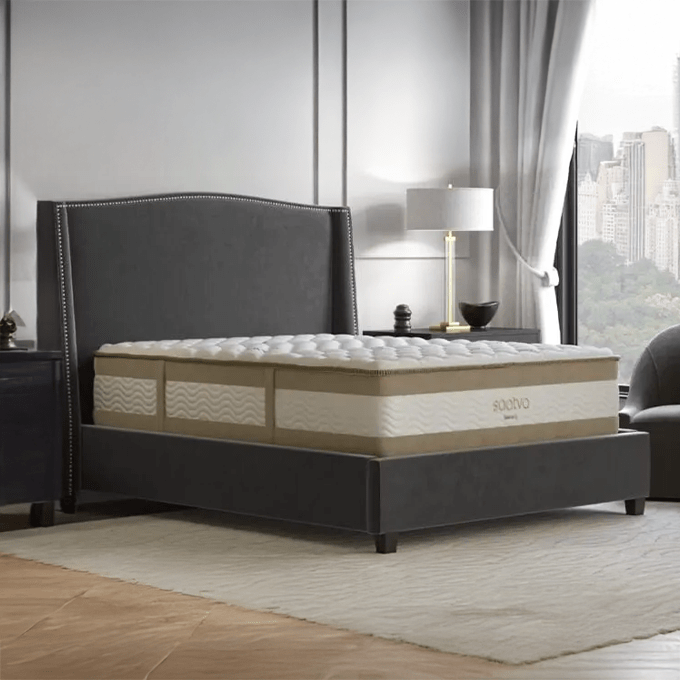
Saatva Rx gives you the ultimate restorative sleep with its firm and targeted structure. Its structure includes a multi-layer Therapeutic Support Core with a dense micro-coil layer and a stronger Lumbar Zone® that incorporates targeted firmness with contouring micro-coils. The mattress uses an organic cotton cover and cooling comfort layers to keep sleep cool and healthy.
This zoned support hybrid mattress for spinal alignment places firmer coils under the lumbar spine while cushioning the hip and shoulder area. This helps your pelvis stay more neutral through the night, decreasing the workload on your lumbar lordosis. Additionally, it gives you medium-firm support to keep your hips from sinking in too deep at night. It also features gel-infused foam and engineered comfort layers to maintain a consistent sleep temperature, promoting uninterrupted sleep that supports tissue recovery.
Saatva Rx is best for people with chronic lower-back pain or sciatica. Its pressure relief feature gives them improved morning comfort over the years of use. The mattress is also suitable for sleepers who want therapeutic lumbar support and anyone seeking a medically oriented mattress. Therefore, using the Saatva Rx mattress along with daily stretching and glute activation exercises can help you manage APT faster. If you want a mattress that acts like a supportive partner for daily therapy, the Rx gives you a perfect mix of stability and alignment.
Pros:
- Targeted lumbar reinforcement and strong pressure relief.
- Breathable organic cover and cooling layers give restorative sleep.
- Strong edge support and durable construction for long-term alignment.
- Comes with Guardin™ botanical antimicrobial treatment to prevent the growth of bacteria and mildew.
Skip If:
- You prefer very plush and slow-sink memory foam.
- You need a soft and cloud-like surface for side-only sleeping.
- You prefer a mattress delivered in a compressed box.
2. Helix Midnight Luxe – Best Mattress for Anterior Pelvic Tilt Side Sleepers

The Helix Midnight Luxe provides you with pressure relief and targeted support in a way that helps protect pelvic alignment through the night. Its best features are zoned latex or coil layers and the GlacioTex™ cooling top to give you optimum support and control surface temperature at night. The option of the cooling cover keeps sleep temperature comfortable, which is very important if you seek overnight recovery. This cooler and undisturbed restful sleep aids in tissue repair and reduces nighttime tossing and turning due to discomfort.
The structure is designed with a zoned coil system that gives firmer hold under the lumbar area and softer contouring at the hips and shoulders. This design keeps the hips from dropping too deep and the pelvis from rotating forward. Such APT-friendly features make the Midnight Luxe useful for side sleepers, because it maintains a more neutral posture without compromising relief at the hips. The mattress’s medium firmness level gives a balanced softness and lift, helping back and side sleepers find a stable sleeping position that reduces morning stiffness.
This mattress is best for side sleepers and couples due to its motion isolation features. If you use this mattress with a knee pillow, it becomes an effective combo for maintaining pelvic alignment all night. For people who want long-term spinal correction and hip pain relief, the Midnight Luxe’s targeted zones and breathable top make it an ideal fit.
Pros:
- Strong support that protects the lower back and resists excessive hip sinkage.
- A cooling mattress that reduces night sweats and supports uninterrupted sleep.
- Good motion isolation for couples.
- Responsive feel with strong edge support, making it easy to move and get in or out of bed.
- 100-night sleep trial and limited lifetime warranty.
Skip If:
- You are a stomach-sleeper who wants an ultra-firm surface
- You prefer the all-natural feel of a latex mattress.
- You want a budget-friendly option.
3. Amerisleep AS3 – Best Pressure Relief Mattress
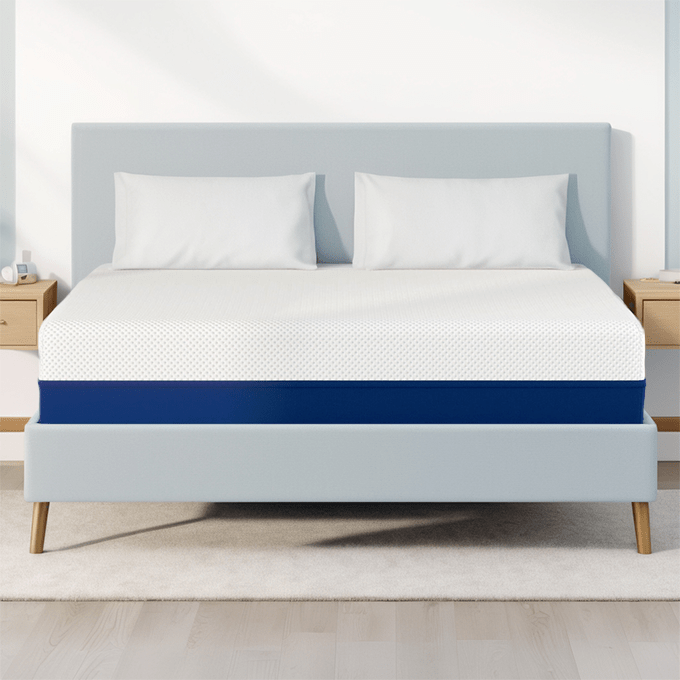
Amerisleep AS3 provides you with the best cushioning and support features to align with your sleeping posture while soothing pressure points. Its core is made of plant-based Bio-Pur® foam with HIVE® zoned technology to deliver breathable and responsive contouring that soothes pressure points. Bio-Pur® foam’s open-cell structure improves airflow, which supports restorative sleep and muscle recovery. In hybrid versions, you get pocketed coils for added lift, with body contouring, breathability, and optimal support.
The AS3’s HIVE® zoning cushions hips and shoulders while offering firmer support under the torso. This helps keep your pelvis at a flat level instead of sinking and rotating forward. Its zoned response provides lumbar support for your nightly stretches and daytime strengthening exercises, reducing the repetitive strain that worsens APT. This mattress is recommended by 98% users as it reduces nocturnal lumbar stress common with anterior pelvic tilt.
This mattress is perfect for side and back sleepers who need balanced pressure relief, couples who seek motion isolation, and eco-conscious buyers drawn to plant-based foam options. Many sleepers find the AS3 effective at minimizing morning stiffness. It relieves concentrated hip pressure while keeping the spine neutral.
Pros:
- Provides you with excellent zoned pressure relief and a responsive yet contouring feel.
- Good cooling performance compared with traditional memory foam.
- Responsive feel that prevents deep sink and makes changing positions at night easy.
- Strong customer ratings and reviews.
Skip If:
- You need an ultra-firm surface for stomach sleeping.
- You prefer a fully innerspring and coil-forward feel.
4. Bear Elite Hybrid – Best Cooling Mattress for Hip and Back Pain Recovery
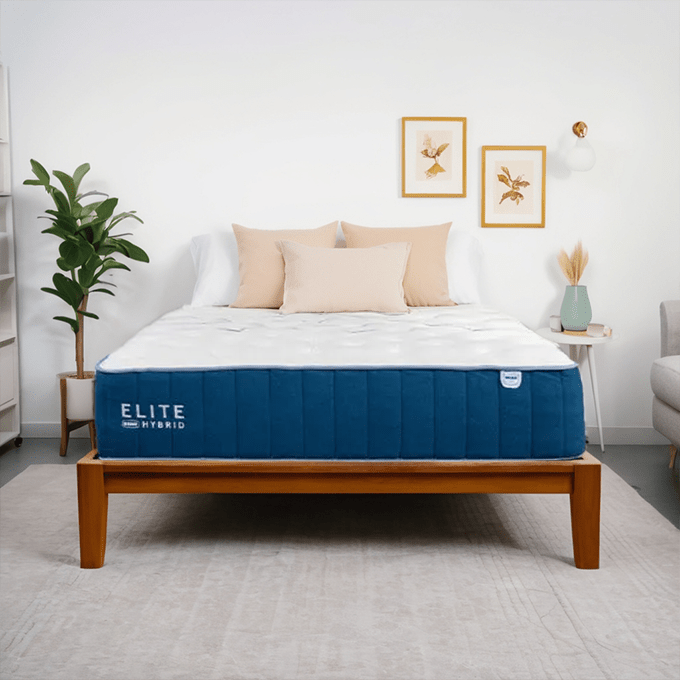
The Bear Elite Hybrid introduces you to a layered design that includes cooling foams and a supportive coil core. It incorporates a 14-inch hybrid build, an optional Celliant®-infused cover, graphite-gel, and copper-infused memory foams. It also includes a zoned pocketed-coil system with multiple firmness choices, designed to boost recovery, regulate temperature, and deliver targeted lumbar support. These components limit hip sink and protect spinal alignment to give you neutral pelvic alignment and hip pain relief. The optional Celliant®-infused cover converts body heat into infrared energy that some studies suggest may boost local circulation and recovery.
Its science-backed construction features graphite-gel and copper-infused foams to draw heat away from the surface and add antimicrobial properties. The zoned pocketed coils place firmer support under the torso and lumbar area with a slightly softer feel at the shoulders and hips. This reduces localized pressure without permitting the midsection to collapse.
In clinical terms, reducing repetitive micro-strain at night supports daytime activities. This is because your muscles can relax properly, and the cushions between your spine bones get the chance to refill with fluid when you sleep in better alignment. Therefore, the Elite Hybrid’s recovery tech and adjustable firmness make it a wellness-oriented choice. It is well-suited for athletes, active sleepers, and anyone who seeks muscle recovery and cooling features.
Pros:
- Recovery-oriented tech (Celliant®) and effective cooling layers.
- Strong zoned lumbar support that prevents the hips from sinking.
- Effective cooling layers and customizable firmness choices.
- Good for heavier or combination sleepers due to coil lift and firmness options.
Skip If:
- You want a plush, cloud-like, and slow-sink memory foam feel.
- You prefer an all-natural latex orthopedic mattress alternative.
5. NECTAR PREMIER – Best Contouring Mattress
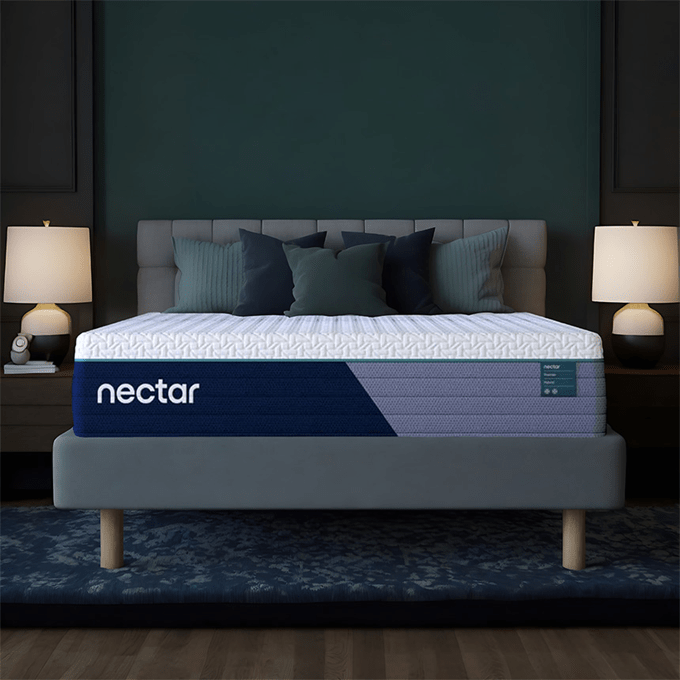
Nectar Premier includes a 13-inch gel memory-foam build with phase-change cooling and transition layers. It delivers deep contouring, motion isolation, and a 365-night home trial with a lifetime warranty for sleepers seeking pressure-relieving comfort. Its construction focuses on soothing your pressure points while protecting spinal posture for people managing anterior pelvic tilt.
The memory foam layers support your hips and shoulders to reduce concentrated pressure. The transition layer prevents your body from sinking, which may result in your hips dropping below the torso. These components of its core help keep the pelvis more level and the lumbar curve from arching while you sleep.
This cooling mattress is best-suited for side and back sleepers who want close contouring, couples who seek motion isolation, and pressure relief. The phase-change material and gel infusion tech help regulate surface temperature, which prevents you from overheating while you sleep. This is also important for overall muscle recovery and disc rehydration. It isolates motion effectively. Therefore, partners get uninterrupted sleep in their shared sanctuary. To enhance the mattress’s restorative benefits, side sleepers can add a knee pillow, and back sleepers can use a thin under-knee bolster for lumbar support. Overall, it’s one of the best contouring options that complements physical therapy and heals your APT.
Pros:
- Superior contouring that relieves pressure at the hips and lower back.
- Strong cooling tech for a memory-foam design.
- Excellent motion isolation, good for couples.
- Shipped in a compressed box for easier setup.
Skip If:
- You want a highly responsive and coils-first mattress.
- You need an ultra-firm surface for stomach-sleeping with APT.
6. Brooklyn Bedding Plank Firm Luxe – Best Mattress for Stomach Sleepers
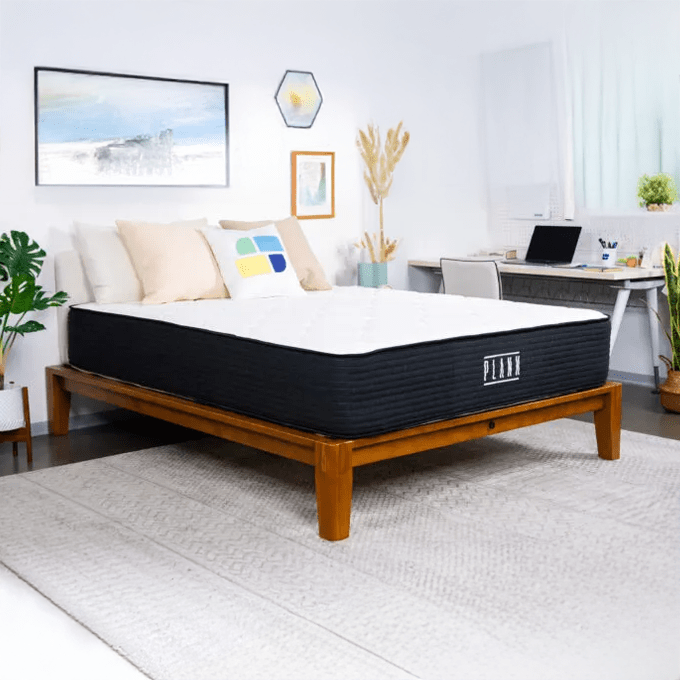
For stomach sleepers and those who need a stabilizing surface, the Plank Firm Luxe provides the best support. It features a flippable dual-sided build offering firm and extra-firm profiles. It is engineered for maximum lift, durable edge support, and a flat sleep surface that resists sagging. By minimizing midsection sink and promoting a flatter sleep surface, its firm top surface reduces forward pelvic rotation and encourages a more posterior pelvic tilt. This lowers lumbar lordosis overextension and provides hip pain relief for those with APT. Its firmness helps keep the lumbar spine from over-arching at night, limiting the extra tension that can worsen lower-back pain.
The Plank’s construction gives you optimal lift and durability, so heavier bodies receive adequate support, helping with long-term spinal alignment and recovery from daily stressors. While it won’t brace the shoulders like softer beds, which is intentional, as the aim is structural support rather than deep contouring.
The mattress is suitable for people who want an orthopedic mattress for posture correction that specializes in lift and flatness. It is an ideal fit for stomach sleepers and heavier sleepers (>230 lbs) who need a very firm and stable surface to avoid hip collapse and reduce lumbar strain.
Pros:
- Prevents hip collapse, reducing anterior pelvic rotation.
- Ideal for stomach sleepers or heavy sleepers needing max support.
- Long-lasting firmness via flippable design.
- Good airflow in the Luxe hybrid reduces heat despite firm foam layers.
Skip if:
- You prefer plush, contouring comfort or deep support at the hips.
- You’re a lightweight side sleeper who needs softer shoulder cushioning.
7. Zoma Boost – Best Mattress for Active Lifestyles
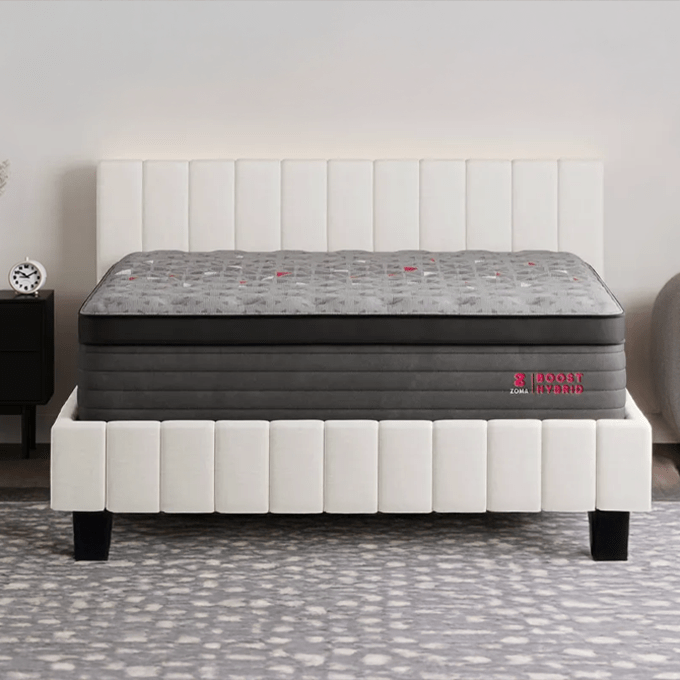
Zoma Boost is a 15-inch hybrid mattress built for performance. It brings you the ideal cooling performance and spinal support to help active sleepers recover while sleeping. The most important feature is Triangulex™, which involves hundreds of triangular cutouts in the comfort layer. These cutouts soften at the shoulders and hips but increase support beneath the midsection. This APT-friendly engineered design prevents excessive hip sink and helps the lower back region stay elevated. It is the exact mechanical behavior you want if you want to manage anterior pelvic tilt.
The Reactiv™ responsive transition layers underneath give a springy and latex-like response, so sleepers don’t feel stuck in foam. This allows easy repositioning and reduces overnight muscle stiffness. The 8-inch pocketed coil support core provides lift and stability, supporting the needs of heavier sleepers or those who want firmer support under the pelvis. Graphite-infused foam and a hyper-cooling top layer improve surface temperature. This further helps you with uninterrupted deep sleep, which is important for tissue recovery that therapists recommend for long-term spinal health.
If you need a mattress that provides pressure relief with resilient support, the Zoma Boost is carefully engineered for this purpose. It is well-suited for combination sleepers, fitness enthusiasts, and people who want a cooling mattress with zoned support.
Pros:
- Excellent zoned support with Triangulex™.
- Fast-responding transition foam.
- Strong cooling performance and supportive coil core for lift.
- CertiPUR-US® certified to give you a non-toxic sleeping environment.
- Well-rated in independent reviews for pressure relief and athletic recovery.
Skip If:
- You need an ultra-soft and contouring foam bed.
- You prefer an all-natural latex mattress or a traditional innerspring (coils-first) feel.
- You require a very firm surface specifically for prolonged stomach sleeping.
Table: Comparison of Top Mattresses for APT
| Mattress | Type | Firmness | Key APT Feature | Best For |
| Saatva Rx | Therapeutic hybrid (dual-coil and micro-coils) | Medium-Firm | FDA-registered Dual-coil lumbar | Chronic back pain, all positions |
| Helix Midnight Luxe | Hybrid (zoned coils and latex) | Medium (5-6/10) | Zoned support with firmer lumbar Softer hip zones prevent hip sink | Side sleepers <230 lbs, couples |
| Amerisleep AS3 | Foam/Hybrid (Bio-Pur® and HIVE®) | Medium (5-6) | HIVE® tech (2,000+ support zones) | Side/back sleepers, Eco-conscious buyers |
| Bear Elite Hybrid | Hybrid | Multiple | Zoned coilsCelliant® recovery for reduced inflammation | Athletes/recovery focus |
| Nectar Premier | All-foam (gel and PCM) | Medium-firm (6.5/10) | Deep-contouring gel foam Phase-change cooling High hip/lower-back pressure relief | Side and back sleepers seeking deep contouring; couples |
| Brooklyn Bedding Plank Firm Luxe | Flippable hybrid (Firm/Extra-Firm) | Firm/X-Firm (9-10/10) | Very low sink Prevents hip collapse and posterior tilt | Stomach sleepers >230 lbs |
| Zoma Boost | Hybrid | Medium-Firm (6-7/10) | Triangulex™ firmer lumbar triangles | Combination sleepers, fitness enthusiasts |
Understanding Anterior Pelvic Tilt and Sleep Posture

When you sit for long durations, it causes excessive stress on the hip flexors while the gluteal muscles remain inactive. Over time, this imbalance leads to tight hip flexors and weakened glutes. The result is a tilted pelvis that creates an exaggerated lumbar curve. It puts extra strain on your lower back muscles and spine. This is also known as the Anterior pelvic tilt (APT).
A medical study shows that most of the lower back patients show signs of APT. It stems from a muscle imbalance, where tight hip flexors pull the front of the pelvis down. Further, inactive gluteal and abdominal muscles fail to counteract this pull, which causes the lower back (lumbar lordosis) to bend.
Let us learn more about how your sleeping position and lack of a supportive mattress can flare up the pain symptoms due to anterior pelvic tilt:
Sleep Position Impact
Your sleeping position plays a huge role in improving your blood circulation at night and aligning your spinal cord for overall good posture. Here is how different positions impact APT:
Side Sleeper
Side sleepers need a bed that cushions the shoulders and hips without letting the hip sink too far. This is because too much sink increases pelvic rotation and can worsen APT-related strain. Thus, you must choose a medium-firm mattress for lower back pain to get the benefits of pressure relief. This will let your hip stay on the same level as the rest of the torso. You can also place a pillow between the knees to keep the top leg from rotating the pelvis and maintain spinal alignment all night.
Back Sleepers
Sleeping on your back can be one of the most effective positions for APT. When you sleep flat, gravity helps keep the pelvis and spine in a more neutral position, even better if the bed provides good lumbar support. You can add a small pillow or rolled towel under the knees to reduce lumbar strain by flattening the lower-back curve and relaxing the posterior chain. For many people with APT, back sleeping and a supportive mattress reduce morning stiffness.
Stomach Sleepers
Stomach sleeping tends to increase lumbar extension (the arch) and can aggravate APT symptoms. It’s the least recommended position if you have a forward-tilted pelvis. If someone can’t stop themselves from sleeping on their stomach, using a very thin pillow or placing a thin pillow under the pelvis can lower the lumbar curve and limit excessive arching. However, sleeping on your back or side is the better long-term option.
Consequences of Poor Support
If your mattress or sleep setup lets the hips sink too far or fails to support the lower spine, you may worsen pain symptoms due to APT. Some of the common issues include increased morning stiffness, low-back discomfort, and irritation of nearby nerves (which can show up as sciatica). Poor pelvic alignment and chronic poor sleep posture may also make pelvic-floor symptoms harder to treat. This is because pelvic mechanics influence the function of the pelvic-floor muscles and the overall recovery. Hence, undersupported hips and an exaggerated lumbar curve can compound pain and slow rehab progress.
Key Mattress Features for APT Correction
When you pick a mattress to help with anterior pelvic tilt, focus on medically useful specs that level your hips and support your lower spine. The right mattress and sleeping surface ease muscle strain, prevent excessive hip sinkage, and help you sleep in a more neutral posture. Let us discuss some of the most important mattress features for APT, why they are important, and the choices you can look for:
Ideal Mattress Attributes for Anterior Pelvic Tilt
| Feature | Why It Matters | Ideal Choice |
| Firmness Level | Prevents hip sinkage and balances spinal alignment overnight. | Medium-Firm (rated 5-7/10) for lower back support |
| Zoned Support | Firmer lumbar zone and softer hip/shoulder zones neutralize pelvis tilt and keep the spine straight. | Critical (e.g., Saatva Rx) |
| Material Type | Responsive materials (hybrid or latex) support without a slow and deep sink that worsens tilt. | Hybrid or Latex |
| Thickness | 12″ and above thickness prevents bottoming out; supports heavier bodies | 12″-14″ (or thicker for heavier sleepers). |
| Adjustable Base | Elevating legs or knees reduces lumbar pressure and lets you find a pain-relieving position. | Highly recommended for symptomatic sleepers. |
Zoned Support
A mattress with specialized and targeted reinforcement in the lumbar or lower back region keeps it from collapsing into a more pronounced arch. For example, when considering Saatva Rx vs Helix Midnight Luxe for back pain, Saatva’s Lumbar Zone® and Helix’s ErgoAlign layer both add firmer support under the midsection. These also provide cushioning underneath the hip and shoulder zones. This design promotes spinal alignment and can be helpful for people managing APT.
Cooling Tech
When you experience overheating at night, you toss and turn more. All this movement means you are constantly shifting out of the mattress’s alignment. Therefore, a cooler mattress helps you stay still in the right position and helps you with lower back recovery. You must opt for mattresses that come with breathable covers and phase-change or moisture-wicking fabrics like TENCEL™, gel-infused layers, or ventilated coil bases. These features make a cooling mattress feel fresher and reduce sleep disturbances that may delay pain recovery.
Edge Support
Without strong edges, the mattress sags and forces your pelvis into that same forward tilt that aggravates your APT. Thus, you need good edge reinforcement that gives you proper support even when you’re getting in and out of bed. This really helps you if you are suffering from hip stiffness due to APT. For example, Saatva and Helix models provide you with strong edge support that prevents the mattress from sagging at the sides.
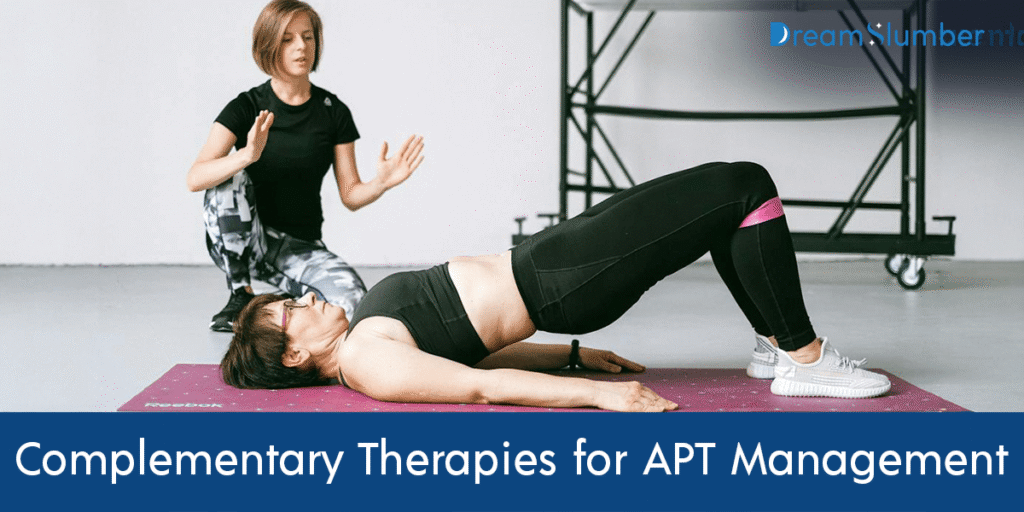
Complementary Therapies for APT Management
When it comes to managing your APT, the persistent pain and stiffness may restrict your everyday movement. Therefore, to ensure you address the problem gradually, you must add stretching exercises and adjustable beds with position presets to give you the nightly recovery you need. Let us discuss these therapeutic strategies in detail:
Stretching
Daily hip flexor stretches, such as half-kneeling lunges, standing quad/hip flexor stretch, and gentle cobra/back extensions, loosen the tight front chain that pulls the pelvis forward. You must include stretching with targeted glute and core activation, such as glute bridges and clamshells, to rebuild the body’s balance. Also, add foam rolling for the hip flexors and glutes. Research shows foam rolling and stretching can increase hip range of motion and reduce tension when done consistently. These moves reduce strain on the lumbar spine and help the pelvis settle toward a neutral position.
Pillow Strategies
When you add pillows beneath your knees or lower back, it can give you the targeted sleep posture. For side sleepers, a knee pillow or full body pillow keeps the front leg from rotating the pelvis and maintains a neutral stance. Similarly, for back sleepers, a slim pillow under the knees flattens the lumbar curve and eases pressure on the lumbar. These positions are easy to follow and naturally give you lumbar support through the night. If you are researching the best pillow position for anterior pelvic tilt, start with the knee-between-legs approach.
Adjustable Bases
An adjustable bed base can reduce lumbar stress by lifting the legs and placing the body in a partial zero-gravity posture with its built-in presets. This position redistributes weight, lowers spinal load, and can feel easier on the hips and lower back. If you want to use this base with a mattress, look for models compatible with Saatva Rx or zoned hybrids like Helix that maintain zoned support when tilted. An adjustable bed base for pelvic tilt reduces morning stiffness among people with APT.
Professional Care
If pain becomes serious and persistent, it is wise to consult a doctor or therapist to manage APT. A physical therapist or orthopedic specialist can assess your pelvic mechanics and prescribe a personalized program with strength, stretch, and movement exercises. A professional can give you the best advice for mattresses and pillows that fit your body and symptoms. For trusted and condition-specific guidance, you must not rely on home treatment and consult licensed clinicians instead.
Mattress Pitfalls to Avoid with APT
When you’re shopping for a mattress to help with your anterior pelvic tilt, it’s easy to get overwhelmed by all the marketing claims and fancy features. Unfortunately, some popular mattress features can actually make your condition worse instead of better. Let’s walk through the most common mistakes people make when choosing a mattress for APT, so you can skip the trial and error and find relief:
Too-Soft Mattresses
Avoid mattresses that come with deep and slow-sinking memory foam or toppers, for example, thick 3-inch memory foam layers. These can let the hips sink below the shoulders, and the shoulders sink below the hips. The body experiences extreme imbalance due to such mattresses, which increases pelvic rotation and worsens the lumbar arch. For APT, avoid plush setups and instead use a firmer or medium-firm surface that limits hip collapse.
Sagging Mattresses
If your mattress shows a ‘hammock’ like effect with a noticeable dip in the middle section, consider replacing it. Instead of helping your pelvis stay neutral, a sagging mattress pulls it deeper into that problematic forward tilt. Most sleep experts agree that once your mattress sags about 1.5 inches or more, it’s time to start shopping for a replacement. You can easily check this by laying a straight edge across your mattress or using the old “string test” to see how deep the impression goes.
Non-Responsive Materials
Some memory foams are so slow to rebound that they trap you in one spot all night long. This also makes turning or changing positions at night harder. When suffering from APT, being stuck in one position can make your stiffness worse. Hence, look for mattresses with more responsive materials like latex or hybrid designs with pocketed coils. These conform to your shape and bounce back easily to help you move freely, preventing muscle tension overnight.

Frequently Asked Questions
Does a mattress help correct pelvic tilt?
To correct your pelvic tilt, you need a good, supportive mattress that helps with recovery at night. However, a mattress alone cannot fix your pelvis position. You need physical therapy and posture-correction daily stretches to balance your muscles and make your spine neutral over time. For best results, opt for an adjustable bed with a medium-firm feel and a zoned mattress that targets pelvic alignment and limits hip sinkage.
What firmness is best for APT?
For anterior pelvic tilt, a medium-firm (graded 5-7/10) feel offers the best comfort and lumbar support. This optimum firmness level prevents your hips from sinking too deeply into the mattress. At the same time, it offers the required contouring features to adjust the surface according to your spine’s curve. A mattress in this firmness range also helps relieve pressure points and helps your body maintain a neutral stance while sleeping.
Is side sleeping bad for the anterior pelvic tilt?
Side sleeping is not bad for the anterior pelvic tilt. It may actually be beneficial if you sleep on your side with proper support between your knees. You can use a thin pillow or a full body pillow to prevent your hips from rotating forward. Additionally, go for a zoned support mattress like Helix Midnight that braces the shoulders while giving a medium-firm support to the lower back.
How do I know if my mattress worsens APT?
If you wake up daily with muscle stiffness, face difficulty getting out of bed, or face persistent lower back pain, it is possible that your mattress could be worsening your APT. If every night you find yourself tossing and turning to find a comfortable position, or notice a dip or hip sinkage, it is ideal to replace your current mattress. Additionally, numbness, tingling, or pain relief after getting up also suggests your bed lacks pressure relief and support features.
Are hybrid mattresses good for pelvic tilt?
Yes, hybrid mattresses are ideal for anterior pelvic tilt because pocketed coils support the lumbar region while foam or latex layers conform to pressure points. These features keep the hips from sinking and give a neutral alignment for the spine. The hybrid mattresses give you the optimum responsiveness to help you change sleeping position easily. Many hybrids, like Saatva Rx and Bear Elite, add zoned support to ease your pelvic tilt.
Should stomach sleepers with APT use a firm mattress?
Yes, stomach sleeping is considered the worst sleeping position for APT. Therefore, using a firm to extra-firm mattress (7-9/10) prevents the midsection from sinking and worsening the lumbar arch. Firmer mattress surfaces reduce forward pelvic rotation and lower back muscle strain. If possible, practice sleeping on your back or side to manage the APT symptoms in the morning.
Do adjustable bases help with APT?
Yes, an adjustable base can ease anterior pelvic tilt by giving the optimum lift to the legs and reducing lumbar pressure. Leg elevation helps neutralise the pelvis, relaxes tight hip flexors, and improves circulation. To get complete benefits, use it with a Saatva or Helix hybrid mattress that offers consistent lumbar support. Hence, an adjustable base lets you find a therapeutic position that reduces discomfort and aids recovery.
Conclusion: Building a Foundation for Pain-Free Mornings
The best mattress for anterior pelvic tilt promises you nighttime comfort and reduced morning stiffness, helping you reclaim your life from chronic pain. Its medium-firmness provides the support your spine and shoulders need. To further heal your APT issues, add consistent and targeted exercises, stretching, and adopt an ergonomic sleep posture in your daily routine. When you combine the right sleep surface with daily movement, your glutes become more active, stretching your hip flexors.
The path to pain-free mornings isn’t always easy, but it’s absolutely possible. Therefore, invest in a quality mattress that unlocks consistent restorative sleep, allowing you to wake refreshed and move freely through your day.
References:

